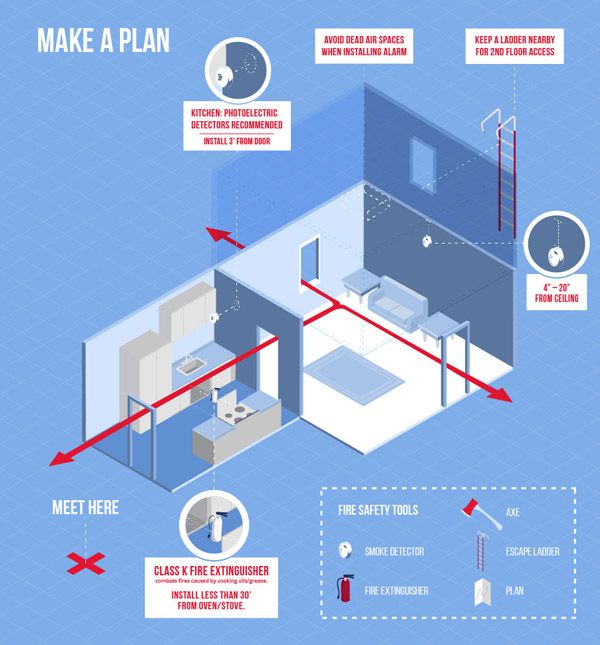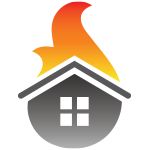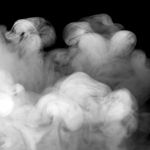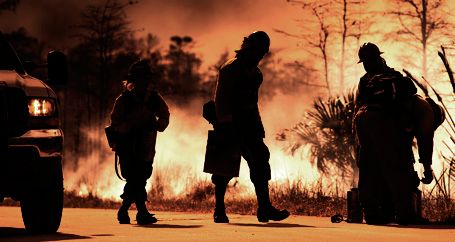I was sound asleep when an earsplitting siren jolted me awake.
Lauren Younger was home alone when the piercing sound of a smoke detector jolted her awake in the middle of the night. In a panic, she made the mistake most homeowners make when a fire or smoke alarm sounds. Here, she describes the night and how her instincts could have turned this disaster into a tragedy.
It happened in August 2016. My husband had just started a new job and was away on business. I was at home alone with Otis, our big old yellow Lab.
It was the usual stay-in evening for me. I warmed up something in the oven for dinner and called my husband. We talked while I ate. After the call, Otis and I headed upstairs to bed and I fired up my laptop to watch TV — something I do when he's out of town because I have trouble falling asleep. I think I drifted off around 10 p.m.
I was sound asleep when an earsplitting siren jolted me awake around 4 a.m. It scared the bejesus out of me. Our house has three levels — bedrooms on the top floor, kitchen and dining on second floor, den on the ground level — and the sound of the alarm was disorienting. At first, I didn't know if it was a smoke alarm or security alarm. And Otis was really freaking out. As I raced downstairs, it didn't take long to figure out it was the smoke alarm. Smoke was billowing out of the kitchen, but I couldn't see flames anywhere.
Our battery-powered smoke alarm is installed in a hallway near the stairs that lead to the ground floor. So I did what anybody would do when you're cooking and the smoke alarm goes off: I grabbed a kitchen towel and I started fanning the acrid, white smoke around the smoke detector. It didn't make a dent. That's when I thought, "What am I doing?"
Where is your smoke alarm installed?

- Avoid "dead-air spaces" where air does not circulate, such as where a wall and ceiling meet
- If it is a wall-mounted alarm, the top edge of the alarm should be at least four inches and no more than 12 inches from the ceiling.
- Alarms on pitched or vaulted ceilings should be installed within three feet of the peak, but not within the apex of the peak (four inches from the peak).
- To help avoid false alarms triggered by cooking, alarms should be installed at least 10 feet from a cooking appliance. Photoelectric smoke alarms are recommended because they are less likely to be triggered by cooking vapors.
The 911 operator said: Get out of the house – immediately.

Asphyxiation from smoke
inhalation is the No. 1 cause
of death in fires inside the
home, by a ratio of 8-to-1
over fatalities related
to burns.—
National Fire Protection Association
I ran back upstairs to grab my cell phone to call 911. (If I'd seen flames, I would've run outside to call 911 from my neighbor's.) The operator said: Get out of the house — immediately. I grabbed Otis' leash and a sweatshirt, and we bolted.
Four fire trucks with sirens blasting showed up within minutes. All our home alarms are linked to our cell phones, so I called my husband to tell him what was happening. Despite all of the noise and flashing lights, only one of our neighbors woke up — and she took in my barking dog, which was a relief.
When I saw the firefighters break out the axes, I was afraid they were going to tear apart our new house. Fortunately, that didn't happen — in fact, they didn't even find a fire. They couldn't find any flames either, which shocked me.
The minute or two I wasted looking for things could have been fatal.
The firefighters had a heat sensor, which led them to the microwave installed above our oven. They removed it and put it outside on the lawn, and asked me if I'd used it. I said no, but that I'd used our new oven earlier to heat up dinner.
As the firefighters left, the source of the smoke was still a mystery. I was thinking, "Smoke with no flames? Is this really over yet?" The remaining fireman stayed behind for an hour to watch for hot spots smoldering inside a wall, but nothing flared up.
I opened the windows to air out the house, which had a strong, horrible smell, like burned rubber. Thankfully, since it was white smoke, there was no smoke damage. After a few days the house smelled normal.
We consider ourselves very lucky. When my husband returned a few days later, we finally identified the source of the smoke: our stove. While he was cooking, huge sparks shot out of the cooktop. Turns out, our new stove had been installed improperly — the wires were crossed, which burned up insulation on the wires.
Here's what I know now: Sure, I learned the value of a smoke alarm. But what this experience really changed is the way I think about our emergency plan. I realized in an evacuation, we'd spend way too much time trying to find things in our three-level home. The minute or two I wasted could have been fatal. Now, everything we need — emergency supplies, a leash, a first aid kit, shoes — is always by the front door. Just in case.
And here's the most important take-away I always tell people: Coming out of a dead sleep to the sound of alarms, it's so hard to think rationally and fight the impulse to fix things. Now I know job number one is just to get all of us out of the house. Everything else can wait.

In less than five minutes, fire can engulf a room and develop fatal, toxic smoke and fumes due to fast-burning synthetic materials, lightweight construction and the open floor plans in modern homes. The rate of flashover — when a majority of surfaces in a room are heated to the point of combustion and emit flammable, toxic gases — is eight times faster in modern homes, compared with homes built in the 1950s and 1970s. —New Science Fire Safety Journal

White smoke often indicates a fire in its first stage, when increasing heat levels cause burning material to release moisture. —FireRescue magazine
Get a quote
Includes personal service from a Farmers agent.
Written by
The information contained in this page is provided for general informational purposes only. The information is provided by Farmers® and while we endeavor to keep the information up to date and correct, we make no representations or warranties of any kind, express or implied, about the completeness, accuracy, reliability, suitability or availability with respect to this article or the information, products, services or related graphics, if any, contained in this article for any purpose. The information is not meant as professional or expert advice, and any reliance you place on such information is therefore strictly at your own risk.
Related articles



